Search Results
Palm tree to be replaced at 16th St. Mission BART Station
Dear Customer: On Monday, July 20, crews will start work at the northeast corner of the 16th Street/Mission Station (near Walgreens) to replace a dead palm tree. Our crews will install a temporary fence, prepare the soil for replanting and then plant the new tree. The planting will be done on Wednesday, July
BART Board to consider Proposed Cell Service Interruption Policy on Dec. 1
Below is the text of the Propoosed Cell Service Interruption Policy currently scheduled for consideration by the Board of Directors at its Dec. 1 meeting. The Board of Directors welcomes comments, which can be provided by clicking on the link here to the feedback form. Download the Proposed Cell Service
Role in the Region: BART plays an important role in the Bay Area meeting its climate goals
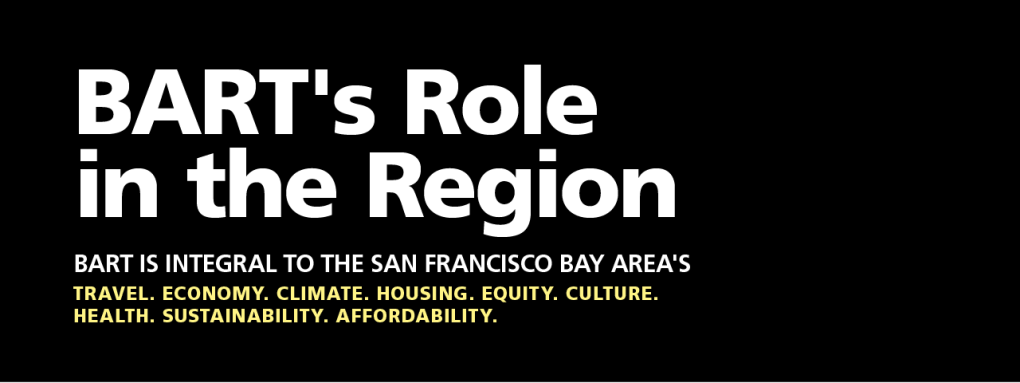
In July, BART released the Role in the Region Report, a comprehensive study of BART's impact on the Bay Area illustrated by new analyses, data visualizations, and powerful personal narratives. Over the coming weeks, we'll be sharing some of the key insights from the report in a series of Role in the Region articles here on bart.gov. Click here to read the first story -- on BART's role in reducing regional traffic -- click here for the second story, which explores BART's contributions to the economy.
We encourage you to read the full report - click here - and visit the project webpage at bart.gov/roleintheregion.
Today's post examines BART's impact on the regional economy. See the full report for methodology.
BART is one of the greenest ways to get around the Bay Area and taking public transit is one of the easiest ways to reduce your greenhouse gas emissions.
Consider these facts:
- Transportation accounts for 38 percent of California's greenhouse gas emissions.
- Driving releases 42 times more greenhouse gases per mile than BART.
- Every BART train car moves as many people as 76 automobiles.
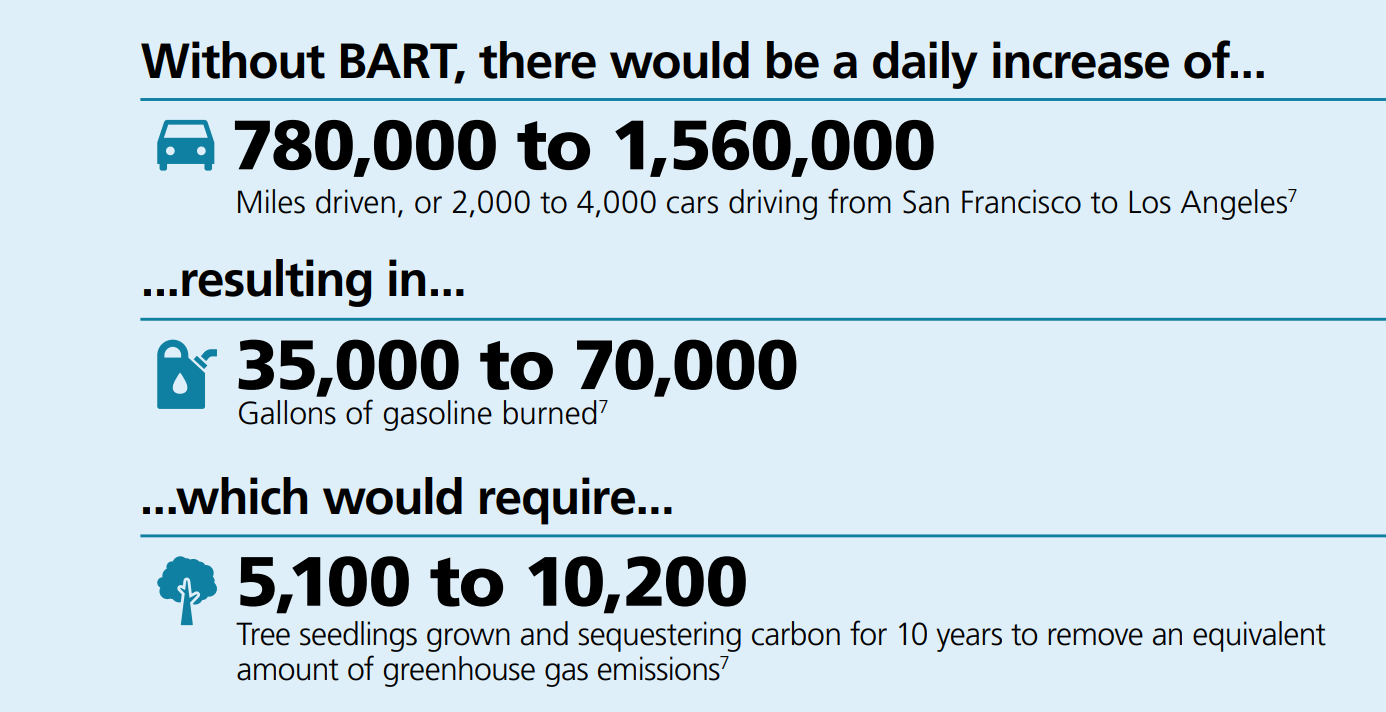
California has a 2045 target date to achieve carbon neutrality and help prevent the worst impacts of climate change. The transition to zero-emission vehicles alone will not happen fast enough to meet state and regional climate goals.
What BART Riders Say…
“I think BART makes the world a better place. It provides an economy of scale, is better for the environment, and allows for more urbanization in the region.”
Samantha Greenstone, High School Student at Orion Academy in Concord
Without BART, there would be a daily increase of 780,000 to 1,560,000 miles driven, which is equal to 2,000 to 4,000 cars driving from San Francisco to Los Angeles. Removing an equivalent amount of greenhouse gas emissions would require planting a new San Francisco-sized forest every two years to offset the extra carbon dioxide.
100 percent of BART’s contracted electricity supply has been greenhouse gas emission-free in recent years, and BART is helping transit agencies operating buses achieve their electrification goals with battery charging at BART stations. BART continues to find new ways to lower emissions; our September 2023 schedule change, which introduced shorter trains and only Fleet of the Future train cars running for the base schedule, resulted in a 15% reduction in energy used per day.
What BART Riders Say…
“To me, BART is a sustainable way of life. When I take BART, I feel like I’m doing my part."
Rider from San Francisco, CA
Taking BART and other public transit options is one good thing anyone can do for the planet.
Learn more about BART's sustainability practices and read the 2023 Sustainability Report at bart.gov/sustainability.
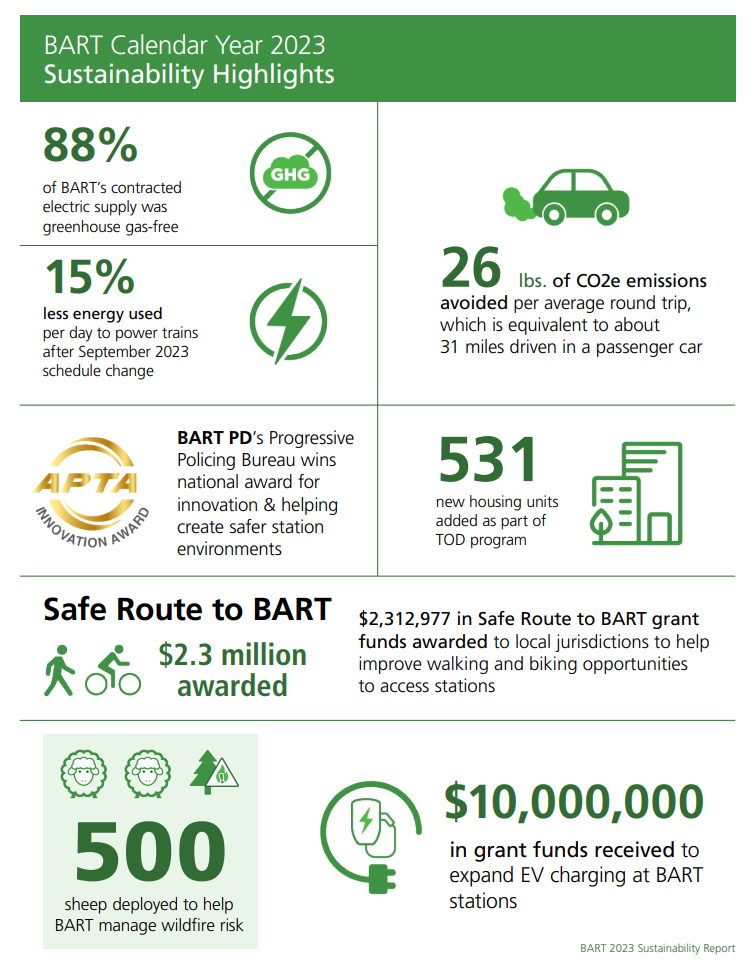
One Book One BART returns with a natural history theme, new book, and 3 outdoorsy events
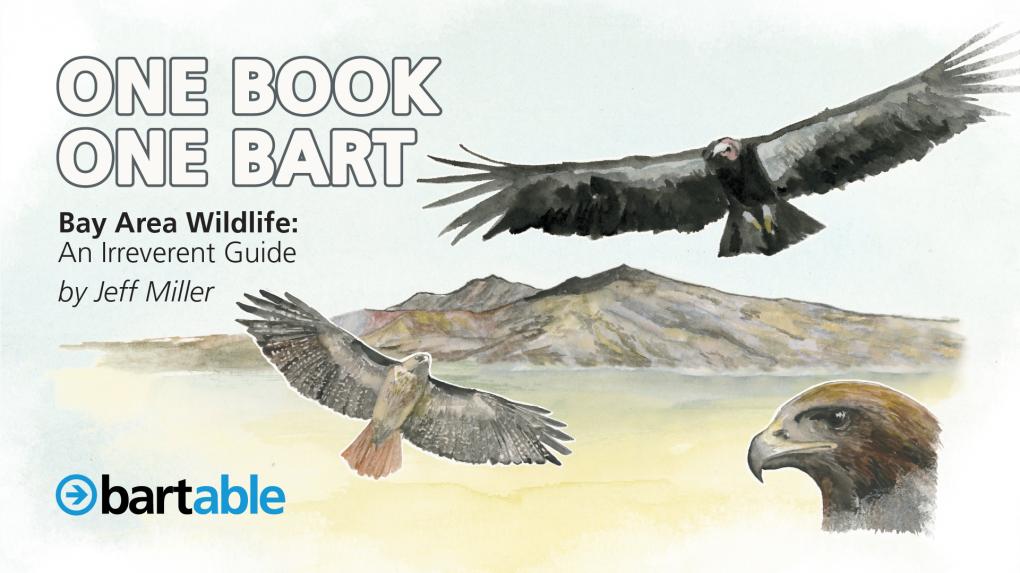
Click here to sign up for the One Book One BART mailing list.
Just in time for National Reading Month, BART is thrilled to announce the One Book One BART Spring 2025 book club, this time with a natural history-themed group read and three events for nature lovers of all ages and interests (scroll down to “Events” for more info).
BART's book club is novel strategy for rider and employee engagement that invites members of the public to read the same book at the same time and participate in themed events in BART trains and stations.
As BART faces a significant financial crisis, we are experimenting with new and creative ways to engage community members and get people riding – and excited about – BART. One Book One BART encourages people to get on BART and experience the region’s abundance of transit-accessible adventures, all while celebrating the long tradition of reading books onboard.
"The BART book club's natural history theme is an inspiration to get out and explore the remarkable place in which we live," said BART Board President Mark Foley. “BART can transport you to so many green spaces, from the urban wilds of Lake Merritt to the mudflats of Point Isabel, and it takes you there in earth-friendly style.”

This year’s official One Book One BART selection is Bay Area Wildlife: An Irreverent Guide by local conservationist Jeff Miller, with illustrations by Oakland-based artist/author/conservationist Obi Kaufmann. Bay Area Wildlife, which is published by Berkeley-based nonprofit Heyday Books, takes an educational and highly entertaining approach to the region’s local fauna, “revealing why each of these creatures matters, as well as the threats that loom over our region’s incredible biodiversity.”
"How cool that Bay Area Wildlife is the selection for this year’s BART book club, connecting Bay Area residents with our open spaces and wildlife neighbors," said author Jeff Miller. "When you get outdoors to explore, definitely ditch the car and use public transit for your Bay Area wildlife expeditions. Our car-centric culture results in a disturbing toll of road-killed animals, fragmentation of wildlife habitat, and spewed emissions that are altering the climate to the point of impending species extinctions. How we move through the world also affects us and how we perceive our surroundings. Riding BART is a great way to do yourself and the planet a favor while connecting with our amazing bioregion."
Added Gayle Wattawa, general manager and editorial director at Heyday Books: “Heyday is thrilled to partner with BART on this innovative book club. One of the many reasons we take BART is that we get to read on board! And we get to feel good about the environmental impact. So why not pick up this funny Bay Area nature guide published by a local nonprofit publisher at a BARTable independent bookstore (yay, you!), admire Obi Kaufmann's beautiful artwork, read it—and laugh out loud—onboard, and exit the station more deeply attuned to our beautiful natural setting? All the wins.”
Bay Area Wildlife will serve as a jumping off point for a series of free outdoor excursions by BART stations and on trains – just pay your fare! The events are intended to encourage the public to take BART to explore and witness the Bay Area’s wealth of natural phenomena. Public transportation is one of the greenest ways to get around, and the many at-risk wildlife populations who call the Bay Area home are yet another reason to prioritize sustainability when you travel. Focusing on nature is also a key theme of Earth Week, which is celebrated globally during the week leading up to April 22. BART is committed to raising awareness about environmental issues and ways that BART riders can do their part to protect our planet.
“This year’s One Book One BART book club emphasizes that our transit network connects us to places and people, flora and fauna,” said BART Communications’ Michelle Robertson, Principal Marketing Rep., who created One Book One BART. “BART provides access to so much more than urban centers – did you know there are 900 parks located within a mile of our stations? It’s true! So pick up a copy of Bay Area Wildlife, hop onboard a train, and explore the majestic natural world that surrounds us – that includes gazing out of the big windows onboard our trains. You never know what natural wonders you’ll discover!”
Bay Area Wildlife illustrator Obi Kaufmann also created three original paintings that feature wildlife found by BART. The works will soon be displayed in ad spaces across the BART system.
Get going on your next outdoor adventure, by visiting bartable.bart.gov/outdoors to discover a wealth of hikes, bike rides, and outdoor itineraries by BART stations. And check out the many libraries accessible by BART.
One Book One BART homepage: bart.gov/bookclub
Download the One Book One BART flyer to print and post here [pdf]
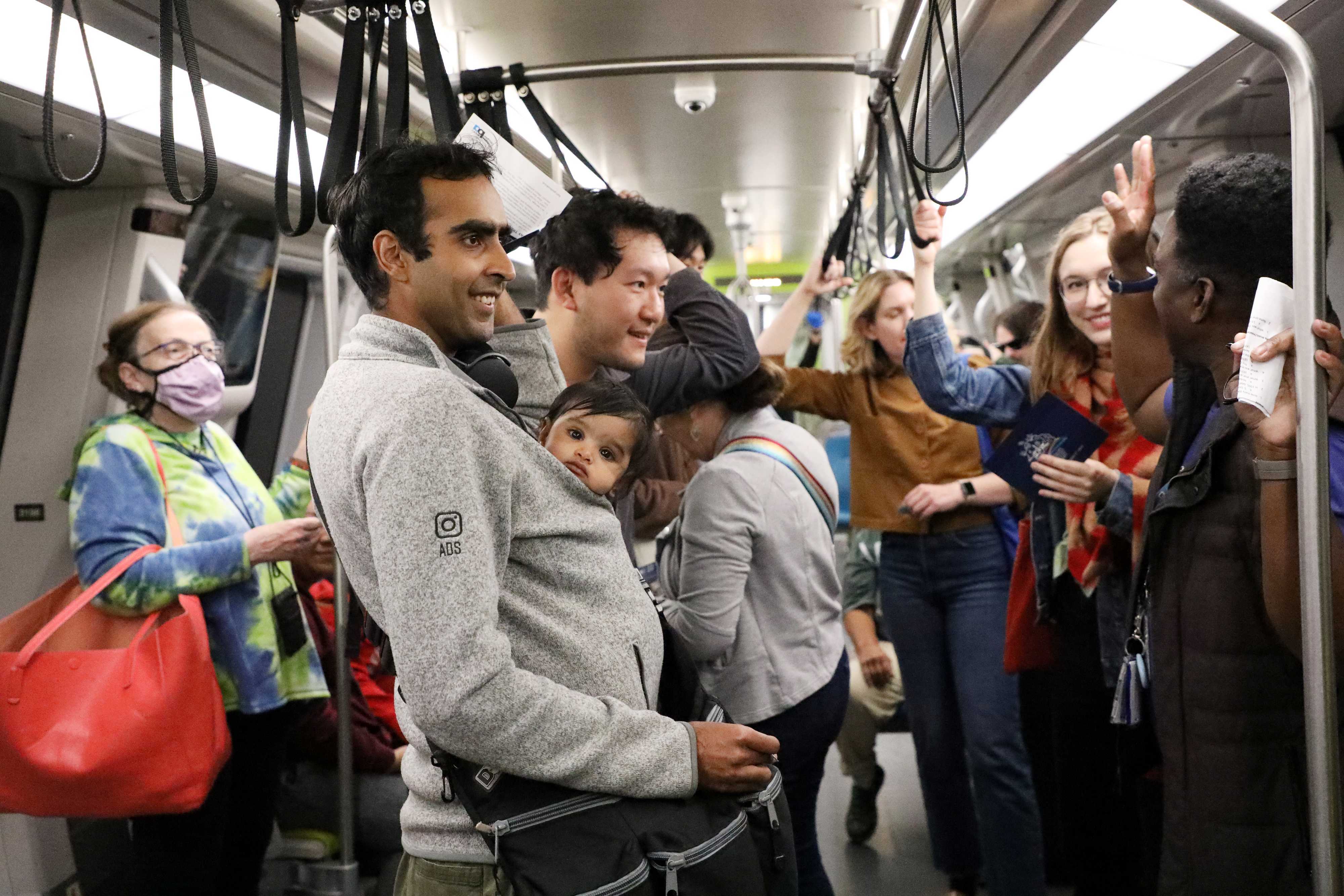
A photo from One Book One BART’s 2022 ”train read-in,” a book club on a moving, in-service train.
One Book One BART Events
All events are free to attend. Just pay your BART fare!
Guided Nature Walk with Author Jeff Miller and Pals
When: Saturday, April 19
The first walk will leave the station at 9am. The walk from 19th to Lakeside Park will take approx. 45 - 60 minutes. RSVP for the first walk (9am) on Eventbrite here
The second walk will leave the station at 11am. The walk from 19th St. to Lakeside Park will take approx. 45 - 60 minutes. RSVP for the second walk (11am) on Eventbrite here
Where: 19th St/Oakland Station to the Rotary Nature Center
Itinerary subject to change.
Meet Bay Area Wildlife author Jeff Miller as he and some conservationist colleagues and local naturalists take us on a ~1.4-mile guided nature walk of Lake Merritt that will begin at 19th St. Station in Downtown Oakland.
Expect to see lots of water birds and an assortment of herons and egrets, maybe even some fish! The walk will end in the grassy area adjacent to the Rotary Nature Center on the lake, where participants will have the opportunity to rendezvous with and learn from local environmental organizations.
Wear comfy walking shoes, fill up your water bottle, and bring whatever else you may need for the walk. And don’t forget your copy of Bay Area Wildlife – Jeff will be signing books.
Bike Ride and Birdwatching
When: Saturday, April 26
- Early short ride - Departs North Berkeley Station at 7:45am. The ride is approx. 8 miles roundtrip and will end at North Berkeley Station at approx. 9:45am. RSVP for the 7:45am short ride on Eventbrite.
- Long late ride - Departs North Berkeley Station at 10am. The ride is approx. 15 miles roundtrip and will end back at North Berkeley at approx. 1pm. RSVP for the 10am long ride on Eventbrite
Where: North Berkeley Station
Itinerary subject to change.
Heath Maddox, BART Manager of Bicycle and Micromobility Access Programs, and local birdwatchers will host two bike rides -- a shorter one for early birds and a later one for those looking for a long ride -- with birdwatching stops along the way. The ride will start and end at North Berkeley Station.
In addition to the expertise of local birdwatchers, we’ll have a digital guide featuring info on birds we might spot on the ride. Find the short 7:45am route here and the long 10am route here.
Bring your bike, helmet, and binoculars – we’ll have extras on hand to lend. You should also bring anything you need to be self-sufficient and keep your bike rolling (spare tube, patch kit, pump, etc.). If you do not have a bike, you can rent one from the Bay Wheels hub at North Berkeley Station.
BART Train Expedition with Obi Kaufmann
When: Saturday, May 3, noon to approx. 1pm
Where: Pleasant Hill/City Centre Station to 12th St/Oakland Station
"Bay Area Wildlife" illustrator and acclaimed poet-naturalist Obi Kaufmann takes the public on a first-of-its-kind BART Train Expedition! The free, family-friendly ride on an in-service passenger train will take us on a journey through the East Bay’s mosaicked, ecological landscape – all through the windows of a Yellow Line train. During the ride, Kaufmann will transport us through “deep time” as he tells stories about the area’s ecosystems, water, fire, infrastructure, volcanic history, trees, and more.
At the end of the approx. 30-minute ride, we’ll disembark at 12th St./Oakland Station and walk with Obi to Frank Ogawa Plaza, where we’ll pay homage to the Town’s most famous oak tree.
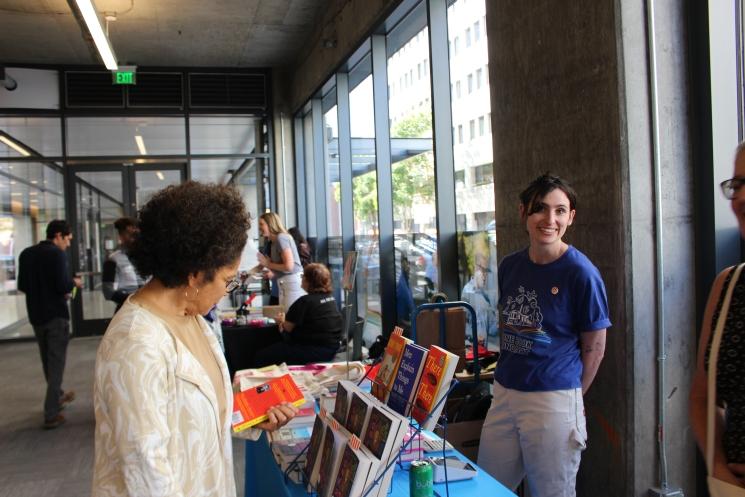
A photo from BART HQ Book Day 2023, a celebration of books and community held for employees at BART HQ.
Where to find the book
Bay Area Wildlife is available for purchase at many local bookstores, including our One Book One BART independent bookstore partners, who are offering 20% off the title when customers show their Clipper cards. All of our partners are within a mile of a BART station:
Banter Bookshop - Fremont Station
Bird and Beckett – Glen Park Station
Books on B - Hayward Station
Mrs. Dalloway’s - Rockridge Station
Orinda Books - Orinda Station
Spectator Books - MacArthur Station
Tally Ho! Books – MacArthur Station
You can also check the title out from local libraries – find BARTable’s roundup of libraries accessible by BART here – and on the digital app Hoopla.

Win a copy of Bay Area Wildlife + BART swag
BARTable will be running a sweepstakes for free copies of "Bay Area Wildlife" and other One Book One BART prizes on the BARTable Contests and Deals page. The sweepstakes will run from March 24 to March 30.
We'll also be running social media contests on BARTable’s Instagram.
Keep up with One Book One BART contest announcements by signing up for the book club mailing list (see instructions at the top of this page) and the BARTable This Week newsletter.
About Jeff Miller
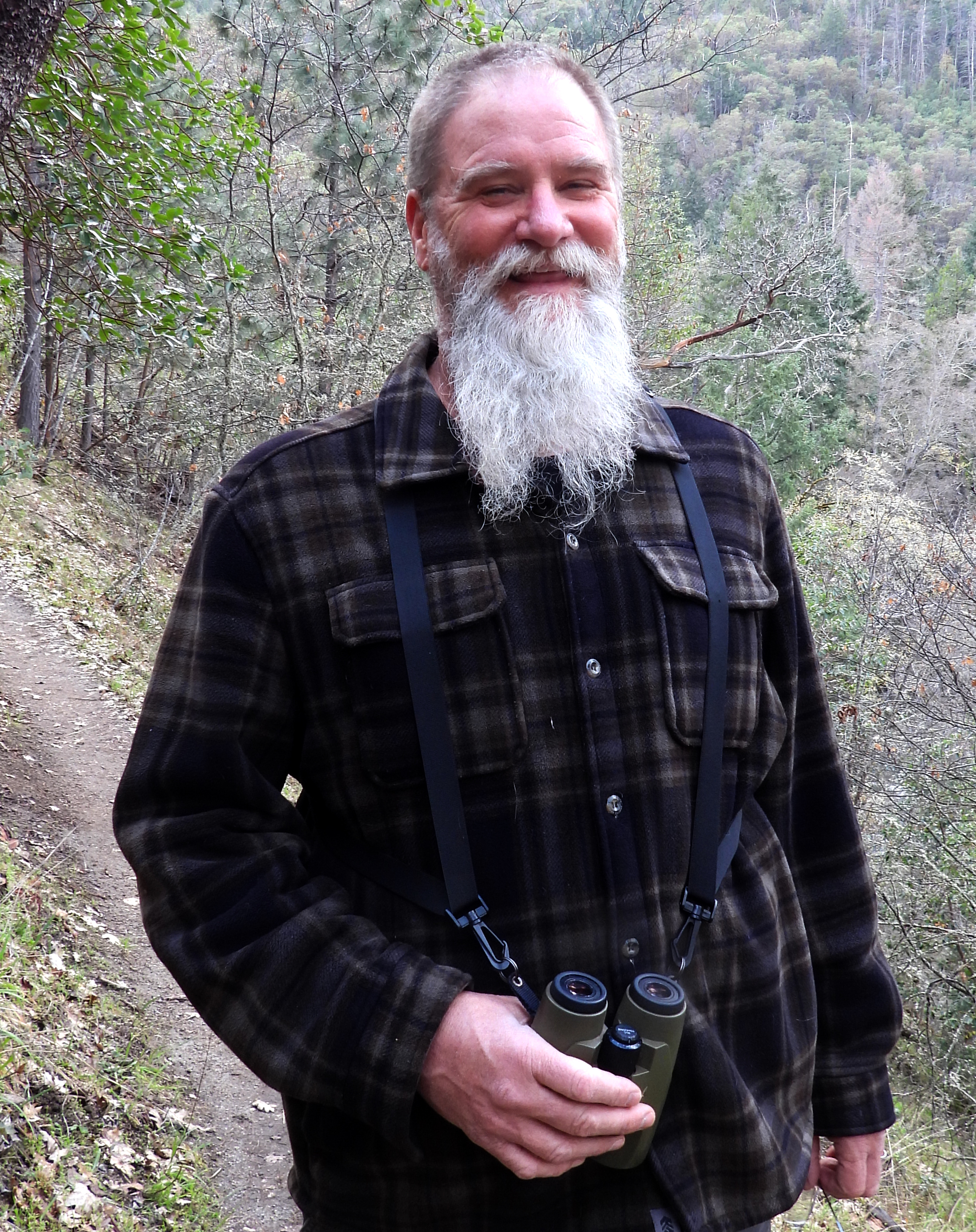
Jeff Miller is an amateur naturalist, professional conservationist, and passionate advocate for wildlife. Jeff is the founder of the nonprofit Alameda Creek Alliance and has served as its executive director since 1997, working to restore steelhead trout and salmon to Alameda Creek and protect the Bay Area’s largest local watershed. He’s a senior conservation advocate with the Center for Biological Diversity, spearheading biodiversity protection campaigns throughout the Bay Area and California, preparing endangered species listing petitions, writing press releases, and doing public outreach and organizing around wildlife protection issues. Over the last quarter century, he has been involved in conservation efforts for dozens of the most iconic imperiled wildlife species in the Bay Area, the most recent being securing state protections for burrowing owls. Jeff says that loving nature is as important as fighting for it and grieving ecological destruction. People tend to care more about animals and places that they have a direct experience with, so he wrote Bay Area Wildlife: An Irreverent Guide to try to connect readers with our regional fauna and inspire them to make a pilgrimage to witness the Bay Area’s spectacular natural phenomena.
Join BART for Oakland Ballers Public Transit Night (Friday, June 20) + new merch!
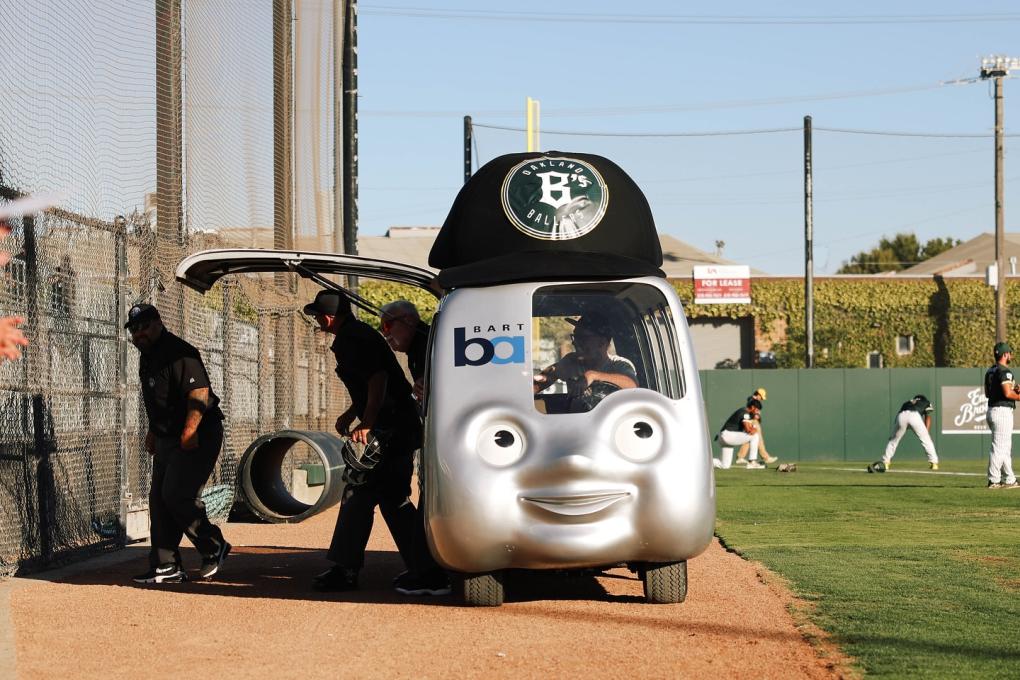
BART is partnering with the Oakland Ballers, the Town’s favorite professional baseball team, for a a special night at the ballpark. Take me out to the BART game!
On Friday, June 20, the Ballers, BART, and AC Transit are hosting Public Transit Night, a celebration of public transportation – the best way to get to the ballgame! Buy your tickets here. The game starts at 6:35pm.
Transit takes center stage for the night with giveaways, an appearance by the BARTmobile, a special BART guest throwing the first pitch, a BART race on the jumbotron, and the children of BART employees serving as ball/bat kid and starting things off with the “Play Ball!” shout.
BART also created new BARTy Ballers t-shirts and stickers to celebrate the occasion, which Railgoods will be selling at the game.
New BARTy Ballers stickers are available to order now on Railgoods here and here.
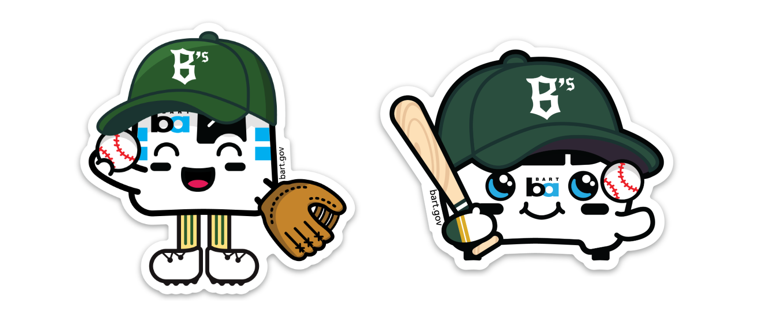
Railgoods is currently taking preorders for t-shirts (expected to ship by Friday, June 20):
This game is celebrating the role public transportation plays in making sure fans can watch their favorite teams play. BART, AC Transit, and organizations like the Ballers are natural partners – transit helps you get there, and the Ballers give you a place to go.
Oakland Ballers Public Transit Night Details
Date: Friday, June 20
Time: 6:35pm
Location: Raimondi Park, 1800 Wood St, Oakland, CA 94607
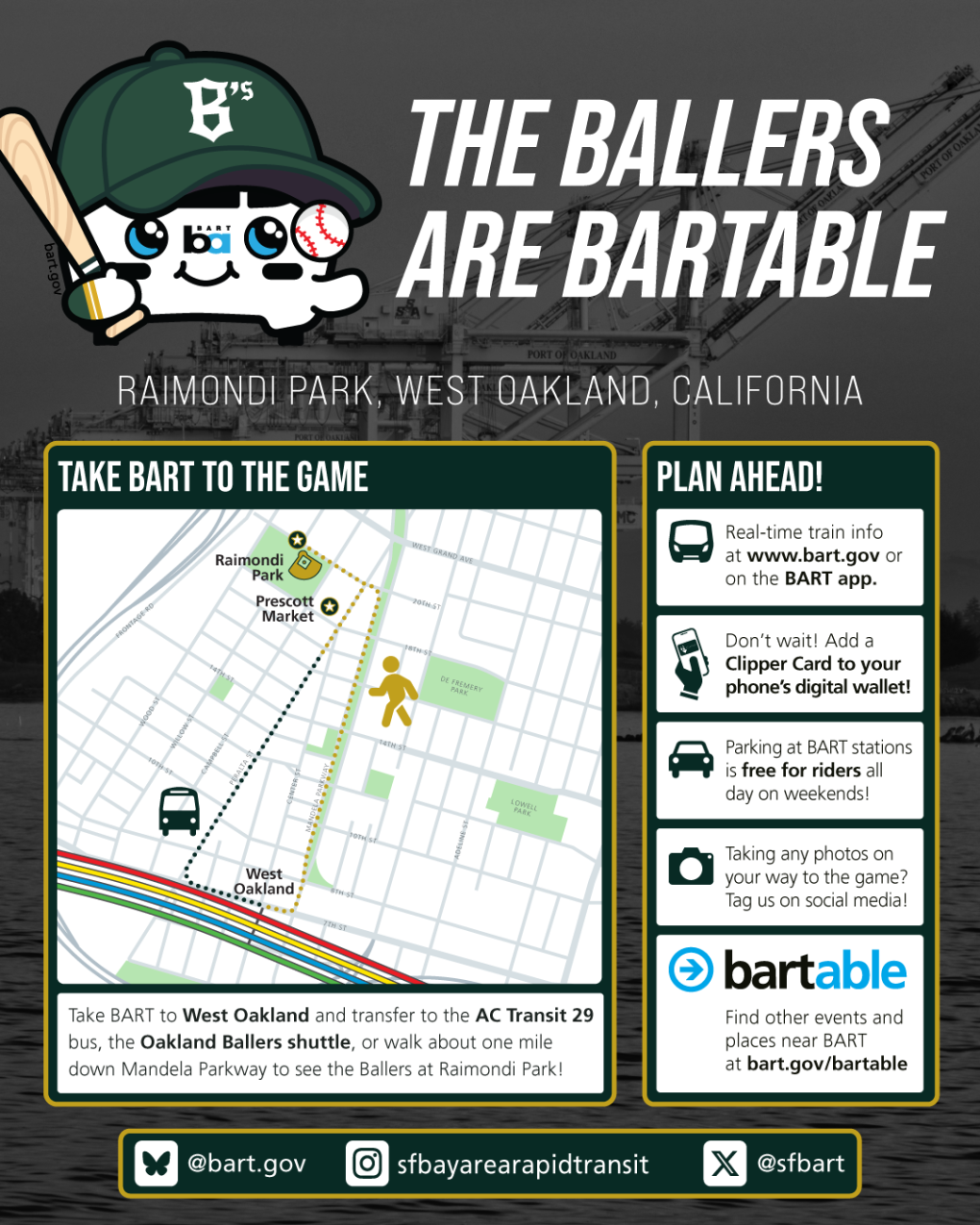
How to get to Raimondi Park
West Oakland BART station is 0.9 miles (about a 15–20 minute walk) from Raimondi Park. Free shuttle buses run between the ballpark and BART station every 20 minutes starting 1.5 hours before game time and a half hour after the game ends. Or take AC Transit Line 29 to the park.
See AC Transit, biking and parking information here.
BART and Oakland Ballers partner for second season
BART and the Ballers entered into a partnership last year ahead of the team’s inaugural season, with the Ballers hosting BART Night at the park in August 2024. The team jerseys prominently display the BART logo.
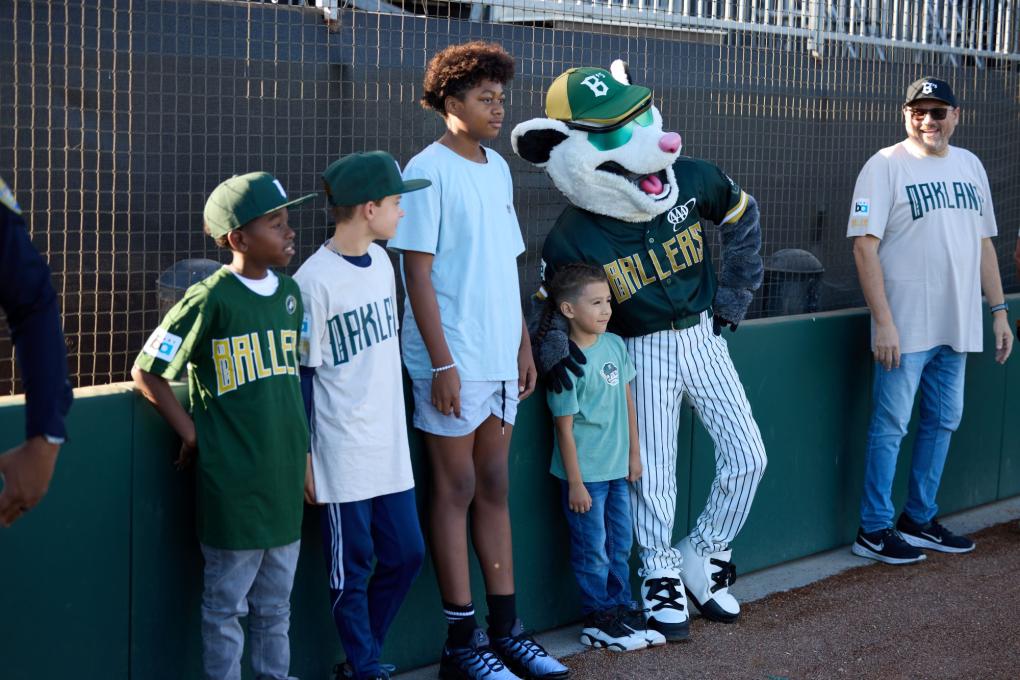
News: Oakland Ballers step up to the plate to save legacy BART car
In April 2024, the Ballers received a decommissioned legacy BART car that they plan to transform into a park concessions stand, to be unveiled next season.
This same car was initially reserved for the Athletics, the professional baseball team that departed the Bay Area in 2024. Team officials emailed BART in 2023 to inform them they would no longer be accepting the car. The Ballers jumped at the opportunity to receive the car – the team was responsible for the cost of transporting the vehicle – and refurbish the emblem of Bay Area history that carries tremendous sentimental value for riders.
Read more about the car delivery and BART’s legacy car decommissioning program.
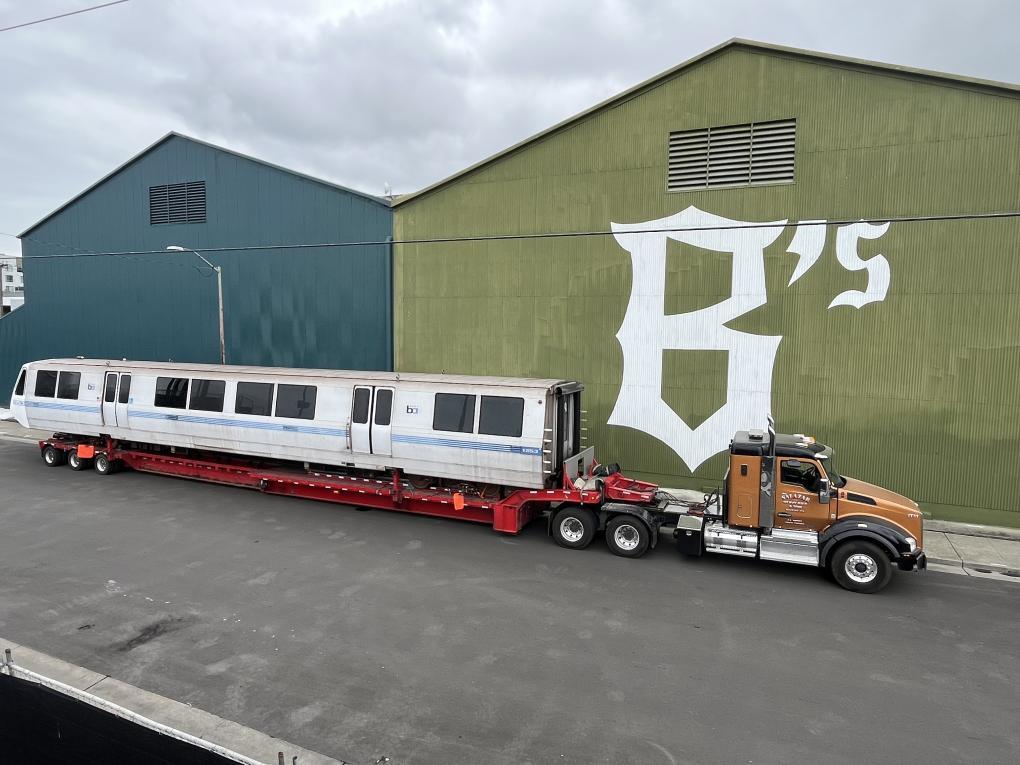
BART will run Sunday service (8am-midnight) for New Year's Day 1/1/24
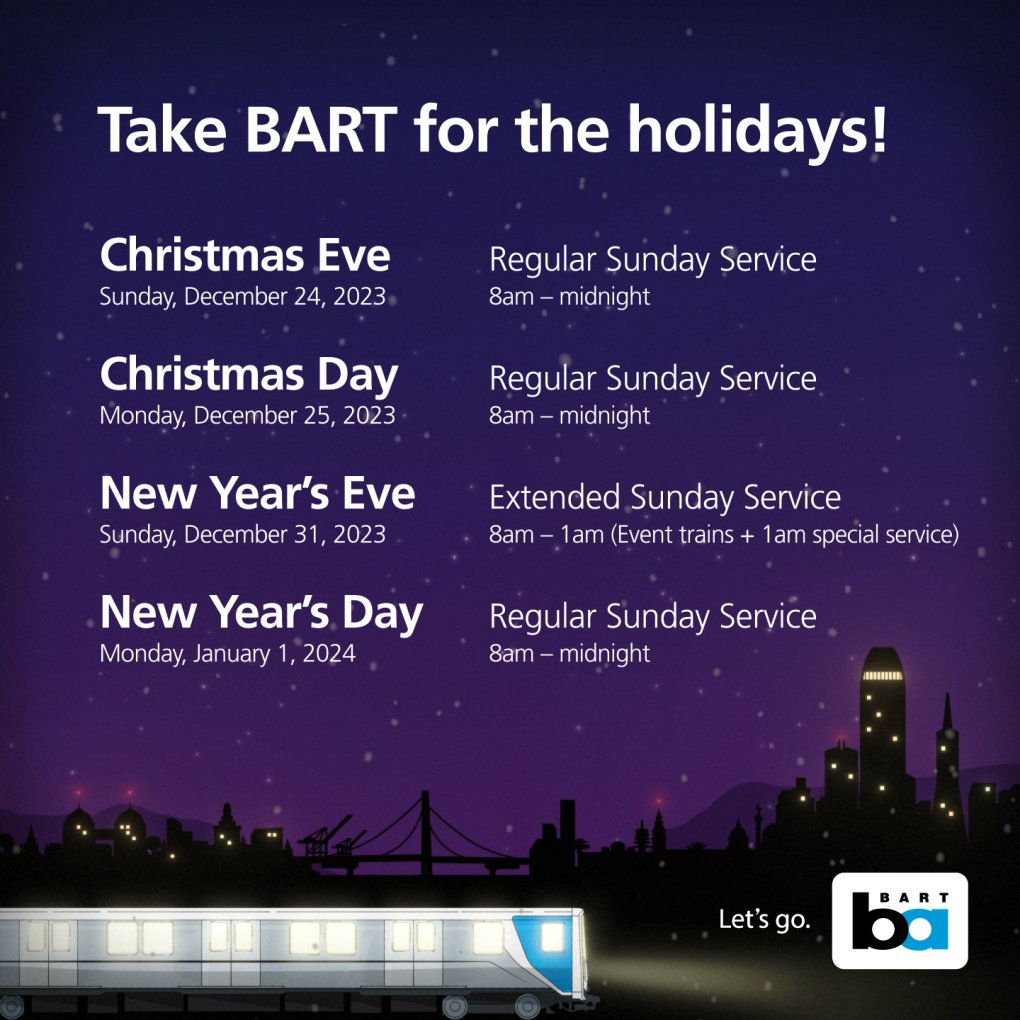
As we wrap up 2023, BART will be running Sunday service on Christmas Day, Monday, December 25, and 2024 New Year's Day, Monday, January 1.
BART service will be the following for the last week of 2023:
Christmas Eve, Sunday, December 24: standard Sunday service (8am-midnight)
Christmas Day, Monday, December 25: Sunday service (8am-midnight) to observe the holiday
New Year's Eve, Sunday, December 31: standard Sunday service (8am-midnight). BART will be providing 1am Extended Service for late night riders coming back from the New Year's Fireworks show in San Francisco or other celebrations.
New Year's Day, Monday, January 1: Sunday service (8am-midnight) to observe the holiday
Parking
Parking is always free after 3pm and on weekends. Parking will also be free on Christmas Day and New Year's Day. This applies to all BART stations except for Milpitas and Berryessa/North San Jose, as they are operated by VTA.
All other parking rules will be enforced.
For those travelling during the holidays and taking BART to the airport, you can purchase multi-day parking in advance through the BART official app. Check out our guide on how to pay for multi-day parking for airport riders.
Download the BART app to pay for parking and trip planning:
Join the fun! Click here to download BART-themed holiday cookie templates!
Holiday coloring sheets:
"A great feat": BART constructs new power substation in one of its busiest stations
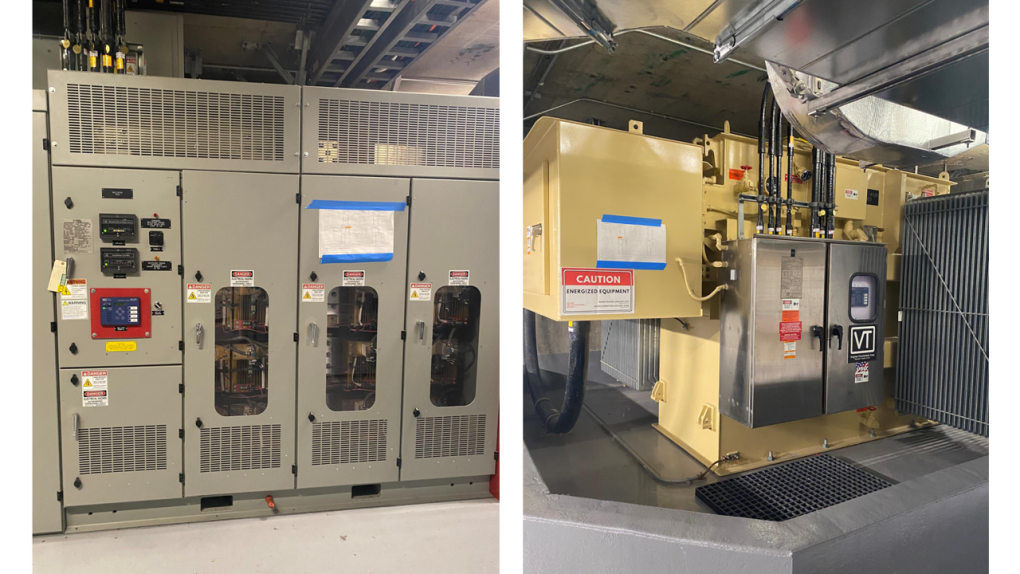
Photos of the completed substation at Civic Center Station.
To read more stories about BART infrastructure, visit bart.gov/railtales.
For the first time since the original BART system was built in the 1960s, BART has completed construction on a brand-new substation facility in the system’s core that is already providing benefits to riders.
Energized in late April, the state-of-the-art traction power substation at Civic Center Station increases the energy available to power BART trains in San Francisco by nearly 18%. (Note: 86% of BART’s contracted energy as of 2024 is greenhouse gas-free.)
“We haven’t done anything like this in the fifty-plus years since BART was constructed,” said Myat San, Chief Infrastructure Delivery Officer, who has been involved in the yearslong project from start to finish. “We’ve replaced substations but never built a facility at an already-constructed station. This is a great feat.”
The energization of the substation provides immediate, tangible benefits to BART riders in the substation’s operating area of Downtown San Francisco, the busiest section of the BART system.
“The substation increases reliability, redundancy, and operational flexibility, which are important for a system as large and complex as BART,” said Javed Khan, Group Manager, Capital Projects. “It also has modern features, including advanced monitoring and diagnostic capabilities.”
This means improved substation performance. If a problem does arise, BART and the Operations Control Center can quickly identify and pinpoint it and dispatch technicians to repair and restore the substation. BART can also source power from the new substation to keep trains running and mitigate system impacts, such as service delays.
“BART’s improvements to station lighting and fare gates are very visible, but with substations, you don’t see the benefits with your own eyes,” said San. “But even if you don’t see these substations, you experience them. They are the unspoken heroes of the system."
The increase in available power from the new substation will also give BART the future capability to run additional trains through the Transbay Tube as part of BART’s Transbay Corridor Core Capacity Program (TCCCP).
What exactly is a traction power substation? It's the equipment that converts energy from PG&E to the electrified third rail that provides the motive power for BART trains to run.
The Civic Center substation has two transformers, each pumping 5 megawatts and running in tandem. The project is one part of TCCCP, a series of strategic investments that will enable BART to increase the number of trains it operates at any given time. TCCCP will see the construction of five new substations, as well as an additional substation at BART’s Hayward Maintenance Complex. These will provide the energy needed to power additional trains, with the objective of running up to thirty ten-car trains per hour in both directions of the Transbay Tube. The project is funded by voter-approved Measure RR and Federal Transit Administration grants.
The project team chose to construct the first of the five new substations at Civic Center because Downtown San Francisco is the busiest part of the BART system with the highest train frequencies. But building a huge substation facility beneath Market Street during the few hours each night that the BART system is closed is as difficult as it sounds.
“We had to get huge components – switch gears, cabinetry, breakers, transformers – into a hole in the ground in the middle of one of the busiest streets in the Bay Area using a 106-foot crane,” said Khan. That’s a tall task.
Some of the equipment weighed 37,000 pounds, and all of it had to be carefully maneuvered into a 15-by-15-foot access hatch cut from Market St. into the station one 3,000-pound section at a time. In some instances, there was less than a foot of clearance between the equipment and the surrounding walls.
A stretch of Eighth St. intersecting Market St. was closed just for this day. Though the process of lowering the equipment took about 12 hours to complete, the project team had been preparing for the moment for more than a year. BART Communications chronicled the crane process in this 2022 article.
The planning and design phases began long before the crane rolled onto Market St. After an initial TCCCP study was conducted in 2015, a consulting firm was brought in to help assess and develop the engineering designs, with inputs, reviews, support, and coordination from BART. The design phase was completed in about 1.5 years, after which the construction contract was put out to bid (also known as the procurement phase). Then came material delivery and construction.
In project management terminology, the space selected for the substation is known as a brownfield, meaning the site was already developed. Brownfield projects pose unique and sometimes unexpected obstacles as engineers must retroactively design and construct within the constraints of the space. A greenspace is like a blank piece of paper; a brownfield space is a paint by numbers.
The age of the BART system adds extra challenges. Building codes and standards have changed considerably since the 1960s and 1970s.
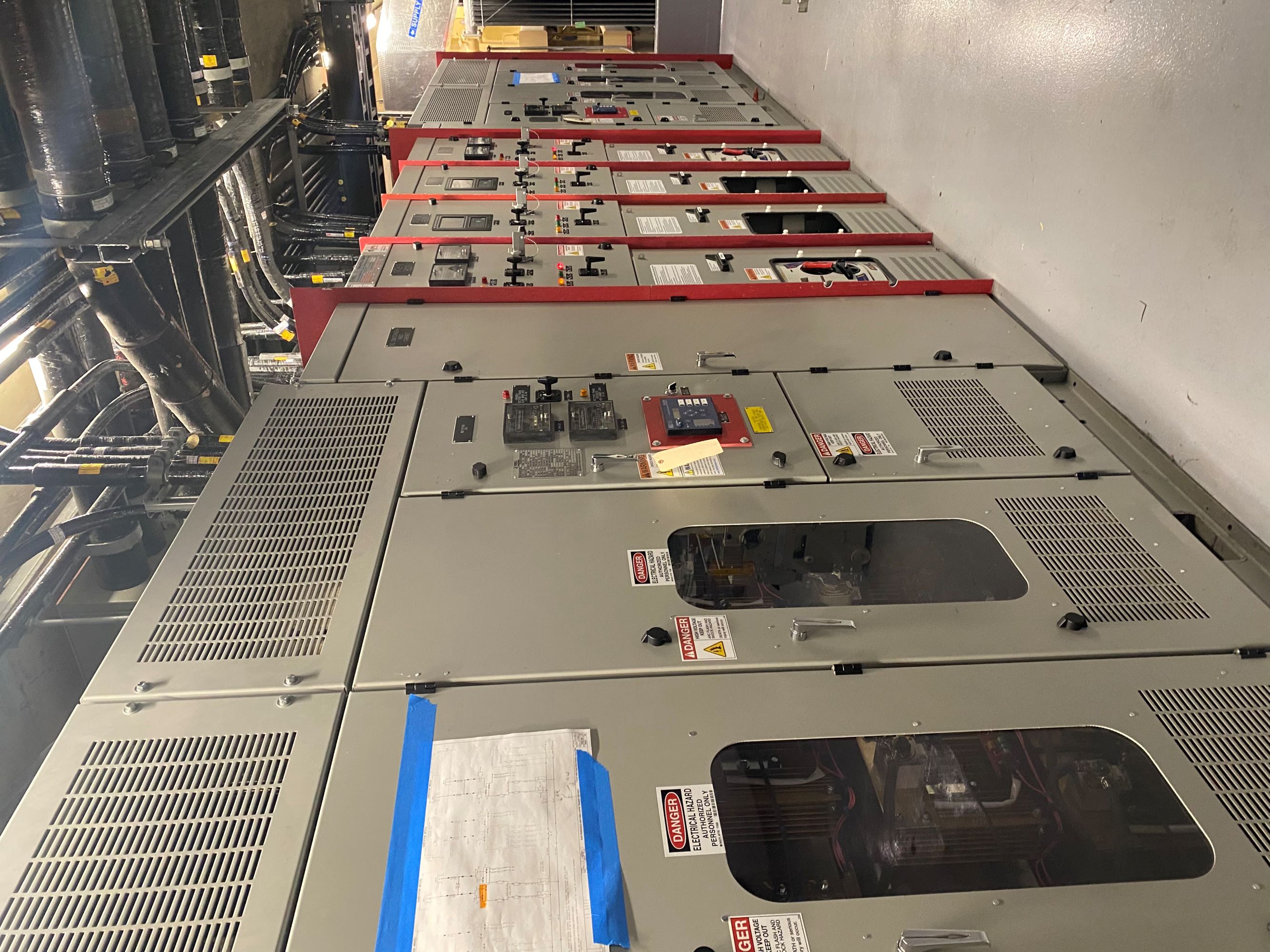
Avineet Garg, the BART project manager, said the team had to secure numerous permits and coordinate with multiple organizations, including the City of San Francisco, the California Public Utilities Commission (CPUC), the San Francisco Municipal Transportation Agency, PG&E, and local businesses.
An added obstacle: Many construction activities took place during what’s known as “the blanket,” or the three hours each night that BART trains aren’t running for passenger service.
“And once you build a new traction power facility, you can’t just start running it until it’s fully tested and confirmed ready to interconnect to the BART electrical grid,” said Juan Ulloa, Acting Superintendent of Power & Mechanical Maintenance.
Thus came the final phase of testing and commissioning. This took about six months, primarily to ensure the newly built systems and equipment were performing as per design and safely integrated with the existing systems and equipment. This culminated in the CPUC-administered, three-day confidence runs during passenger service.
Once the CPUC greenlighted energizing the substation, it started a job that it will hold for many, many years: powering BART trains that carry thousands of people where they need to go each day.
“The coolest part of this process is seeing the thing go from paper to constructed,” said Khan, reflecting on the project. “It’s a once-in-a-lifetime opportunity to be part of this project from start to finish.”
More opportunities lay ahead for Khan and his colleagues. Next up: a brand-new substation at Montgomery St. Station. The project is moving swiftly towards completion and energization.
50 years of service: BART could have been an elevated monorail and other fascinating facts from the Parsons-Brinckerhoff report
A rendering of a “basic supported system” train from the Parsons-Brinckerhoff report of 1956. In celebration of BART’s 50th anniversary this year, we’re looking back at the transit system’s five decades of service and innovation in a new series of stories. BART celebrates 50 years on Sept. 11, 2022. Deep in
BART eliminates multi-million-dollar FY26 budget deficit through cuts and efficiencies
BART has eliminated what was projected to be a $35 million budget deficit for the next fiscal year through various cuts and strict cost control efficiencies. The upcoming Fiscal Year 2026 Preliminary Budget Memo, to be released at the end of the month, will now show a balanced budget for the fiscal year beginning July 1st, but structural deficits of $350 million to $400 million loom in following years unless long term, stable funding sources can be identified.
“We’re getting our budget in order to the extent that we can,” said BART Board President Mark Foley. “Closing a $35 million gap is no easy task. Now that we’ve overcome the first hurdle, we’ll focus on the bigger picture of restructuring BART’s funding model for long term sustainability.”
BART was able to close the projected $35 million dollar deficit through a combination of cost controls and revenue generation. Examples include:
Cost Controls
- A strategic hiring freeze while protecting safety and service quality
- Labor savings from reducing near term retiree healthcare costs
- Non-labor budget reductions across all departments
- Running shorter trains
- Locked-in low renewable electricity rates
- Implementation of Inspector General’s recommendations for efficiencies
Revenue Generation
- Installation of Next Generation Fare Gates to reduce fare evasion and increase ridership
- Maintaining inflation-based fare increases
- Offering new fare products like Clipper BayPass which is now revenue positive
- Improving transit coordination
- Growing ridership through station activations and events
- Negotiating new agreements for telecommunications revenues
Total operating expense growth in the FY26 budget is only 1% compared to inflation in the Bay Area at 2.7% over the past year and the size of workforce has been reduced from the current year due to the strategic hiring freeze. In fact, even before the recent cost cutting, BART has been able to keep its operating costs below the rate of inflation since 2019.
While BART is prioritizing high-quality and frequent service to attract more riders, overall, BART is running 100 fewer trains per week than before the pandemic.
BART is one of the most cost-efficient rail operators in the nation despite operating in a very high-cost region. By one measure, the cost per vehicle revenue hour, BART is significantly more efficient than similar systems like Washington, D.C.’s WMATA and Atlanta’s MARTA (Vehicle rail hour rates: BART - $283, MARTA $370, WMATA $466).
BART cannot close structural deficits with service cuts
As ridership continues to slowly grow, BART’s historical reliance on passenger fares to pay for operations, long seen as very effective, is outdated and no longer sustainable. New sources of funding are needed to avoid significant service cuts.
Even with belt-tightening, BART can’t cut its way out of the crisis without causing a transit death spiral. That is because rail has high fixed costs to maintain infrastructure and low marginal costs driven by changes in service. For example, when BART closed at 9pm and reduced frequencies during the height of the pandemic, it represented a 40% cut in service, but it only reduced operating costs by 12%. Even a 90% cut in service (9pm closure, one-hour frequencies, and running only three of the five BART lines) would close less than half of the FY27 $376 million deficit.
Next steps for the BART budget
The soon-to-be-released 2026 Preliminary Budget Memo will mark the beginning of the final stretch of BART’s budget activity for the year. A series of presentations at Board meetings will culminate in a Board of Directors vote in June to adopt a two-year budget for fiscal years 2026 and 2027.